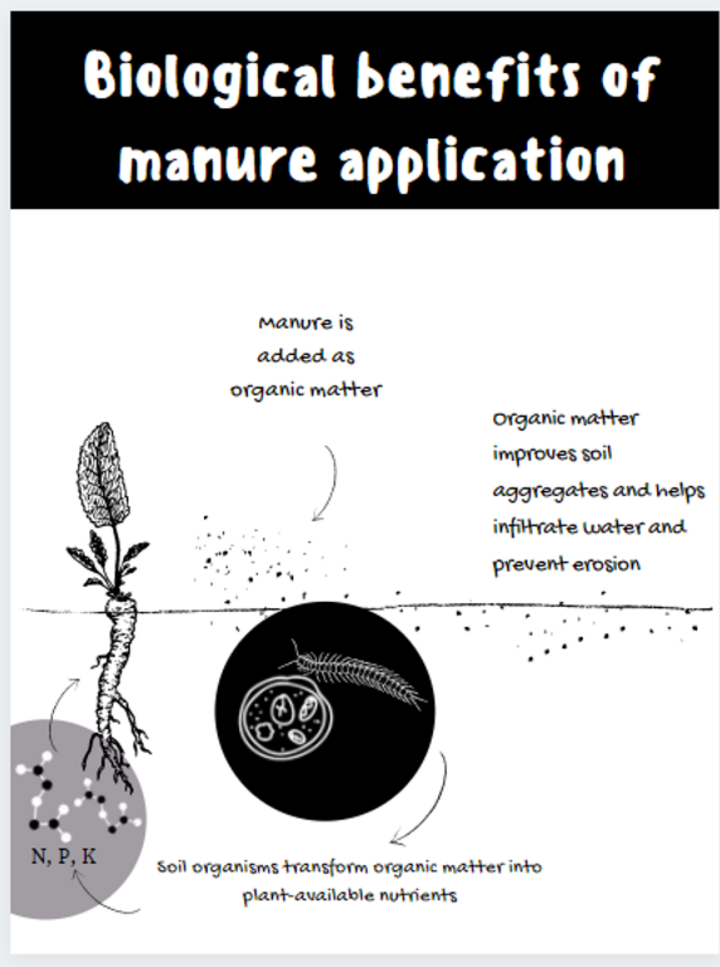Biological benefits of manure application on agricultural soils
Soil quality has been traditionally described in terms of chemical and physical properties; however, soil organisms play an important role in soil health. Some studies suggest that using manure as soil amendment could result in increased microbial biomass, which results in higher soil bacteria, fungi and higher microbial activity. Soil microbial activity is crucial for nutrient cycling, which makes this aspect an important factor to be considered when talking about improving soil health for crop growth. Applying manure to cropland has proven to improve soil carbon content. As a result, microbial activity will benefit aggregate stability, and fertility. (Min, Islam, Vough, & Weil, 2003) (Van Vliet & de Goede , 2006) (De Goede, Brusaard, & Akkermans, 2003), (Menta & Remelli, 2019).
How Can Manure Increase Biological Activity in the Soils?
The carbon content of manure helps increase microbial biomass and soil respiration rates by acting as a feed source for native soil microorganisms. By adding manure as fertilizer, the diversity of bacterial populations in the soil increases. These organisms play a key role in nutrient cycling, making nutrients more readily available for the plants and improving soil physical properties. The presence of microorganisms accelerates the breakdown of organic substances and mineralizes organic nitrogen (N) and phosphorus contained in manure, transforming it in plant-available inorganic forms (Graham, Grandy, & Thelen, 2020). Fungi, among other microorganisms, are part of the soil ecosystem that benefits crops through the relationship they have with roots and the photosynthesis process of plants.
Managing the addition of organic matter, crop rotation and other activities is key to promoting a healthy ratio of organic matter consumption. Agricultural fields with high and dynamic microbial communities in the soils, can be a disadvantage, since the microbes feed on crop residues at a fast rate making the soil vulnerable to erosion and water evaporation. However, the application of manure helps stimulate microbial activity, improving soil aggregation, which results in increased water infiltration and resistance to erosion, soil crusting and in some cases, increased yields (Wortmann et al., 2020).
What Organisms are Living in the Soil?
Soil microorganisms can be classified as bacteria, actinomycetes, fungi, eukaryotes (algae, protozoa), and viruses and each of them have characteristics and functions in the soil. Despite the differences between microorganism species, they interact with each other and the environment, and these interactions have an influence on soil fertility. Some of the microorganisms in the soils and their roles, as described by Johns, 2017 are described below:
- Bacteria in soils have a role in decomposing dead plant material and organic waste. As a result of this role, nutrients are released and made available for consumption by other microorganisms, plants, or enter the soil solution. They play a major role in the nitrogen and phosphorus cycle.
- Actinomycetes are known for giving the soil its characteristic smell.
- Fungi can be both helpful and harmful to other soil organisms. They act as decomposers, converting dead organic material into fungal biomass, carbon dioxide, and organic acids. Other forms of fungi, such as mycorrhizal fungi, are known for their mutualism dynamic with plant roots. They exchange carbon from the plant and make soluble phosphorus and bring other nutrients such as nitrogen to the plant.
- Eukaryotes such as algae are present in most of the soils exposed to moisture and sunlight. They are known for increasing soil organic matter, reducing soil erosion, by binding soil particles, preventing the loss of nitrates through leaching and drainage among other functions. Protozoa have a role in maintaining the microbial/bacterial equilibrium in the soil by feeding from soil bacteria.
The Role of Arthropods in the Soils

Insects that live in the soils make a big contribution to nutrient cycling through decomposition and humification of organic matter. Arthropods transform litter into plant-available nutrients. Arthropods are also considered ecosystem engineers and pulverizers, which means they alter soil structure and promote mineral and organic matter composition. Arthropods create tunnels and galleries that provide adequate aeration and water-holding capacity below ground, facilitate root penetration and prevent erosion from topsoil layers (Bagyaraj, Nethravathi, & Nitin, 2016).
Definition: Humification refers to the stage when organic matter has reached maturity and is available for plants.
References and Additional Reading
Bagyaraj, D. J., Nethravathi, C. J., & Nitin, K. S. (2016). Soil Biodiversity and Arthropods: Role in Soil Fertility. En A. Chakravarthy, & S. Sridhara, Economic and Ecological Significance of Arthropods in Diversified Ecosystems.(págs. 17-51). Springer. https://doi.org/10.1007/978-981-10-1524-3_2
De Goede, R., Brusaard, L., & Akkermans, A. (2003). On-Farm impact of cattle slurry manure management on biological soil quality. NJAS-Wageningen Journal of Life Sciences, 51(1-2), 103-133. doi: https://doi.org/10.1016/S1573-5214(03)80029-5
Graham, E., Grandy, S., & Thelen, M. (22 de October de 2020). Manure effects on soil organisms and soil quality.Obtenido de MSU Extension Agriculture: https://www.canr.msu.edu/resources/emerging_issues_in_animal_agriculture
Johns, C. (2017). Living Soils: The Role of Microorganisms in Soil Health . Nothern Australia & Land Care. https://www.futuredirections.org.au/publication/living-soils-role-microorganisms-soil-health-2/
Menta, C., & Remelli, S. (2019). Soil Health and Arthropods: From Complex System to Worthwhile Investigation. Insects, 11(1), 54. doi: https://doi.org/10.3390/insects11010054
Min, D. h., Islam, K., Vough, L. R., & Weil, R. R. (2003). Dairy manure effects on soil quality properties and carbon sequestration in Alfalfa-Orchardgrass Systems. Comunications in Soil Science and Plant Analysis, 34(5-6), 781-799. doi: https://doi.org/10.1081/CSS-120018975
Van Vliet, P. C., & de Goede , R. G. (November de 2006). Effects of slurry application methods on soil faunal communities in permanent grassland. European Journal of Soil Biology, 42(1), 348-353. doi:https://doi.org/10.1016/j.ejsobi.2006.09.004
Wortmann, C., Iqbal, J., Maharjan, B., & Puntel, L. (2020, May). Soil Microbiology in Nebraska. extension.publications.unl.edu. Retrieved November 06, 2020, from https://extensionpublications.unl.edu/assets/pdf/g2327.pdf
This article was reviewed by Javed Iqbal, Nebraska Extension specialist and Michael Sindelar, Nebraska Extension